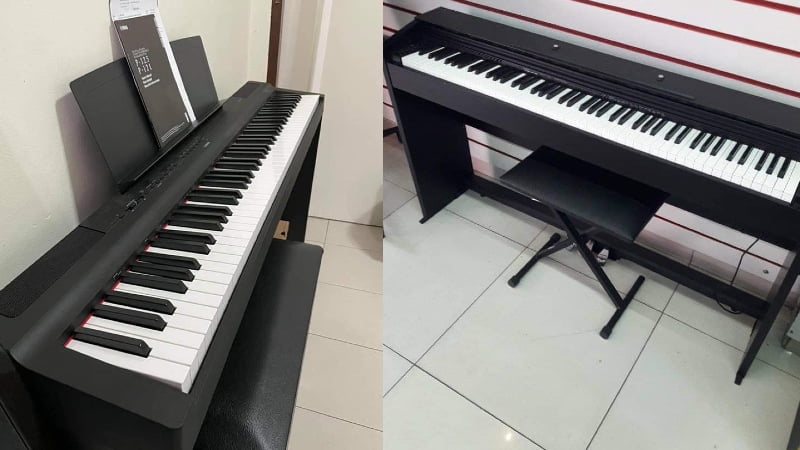When making this Yamaha P125 vs Casio PX-770 comparison, I had a hard time choosing a winner. But after diving deep into the features and giving both pianos a good listen, I had to choose the P125.
While both of these options have great tone, feel, and a couple of extra features, the versatility of the Yamaha P125 put it on top. Aside from being the portable option, the Yamaha P125 boasts more piano voices and extra features than the Casio PX-770, which is why it’s the clear-cut winner.
On the other hand, the Casio PX-770 is still one of the best console digital pianos available on a budget. With top-notch tone generation, a realistic feel on the keys, and a 3-pedal footswitch, this is a great option for those looking for a piano to practice with at home. While it isn’t portable, it’s still a great instrument that any beginner or novice pianist would love.
Yamaha P125 vs Casio PX-770: Comparison Chart




Last update on 2025-04-16 / Affiliate links / Images from Amazon Product Advertising API
Yamaha P125 vs Casio PX-770: Differences
When writing this comparison, I figured the best way to decide on a winner was to compare specific features head to head. And after doing that, I found that the Yamaha P125 was the winner by 3-1. The Casio PX-770, while a great instrument, simply couldn’t beat out the tone, features, and portability of the Yamaha P125.
Feel & Playability
The Winner: Casio PX-770
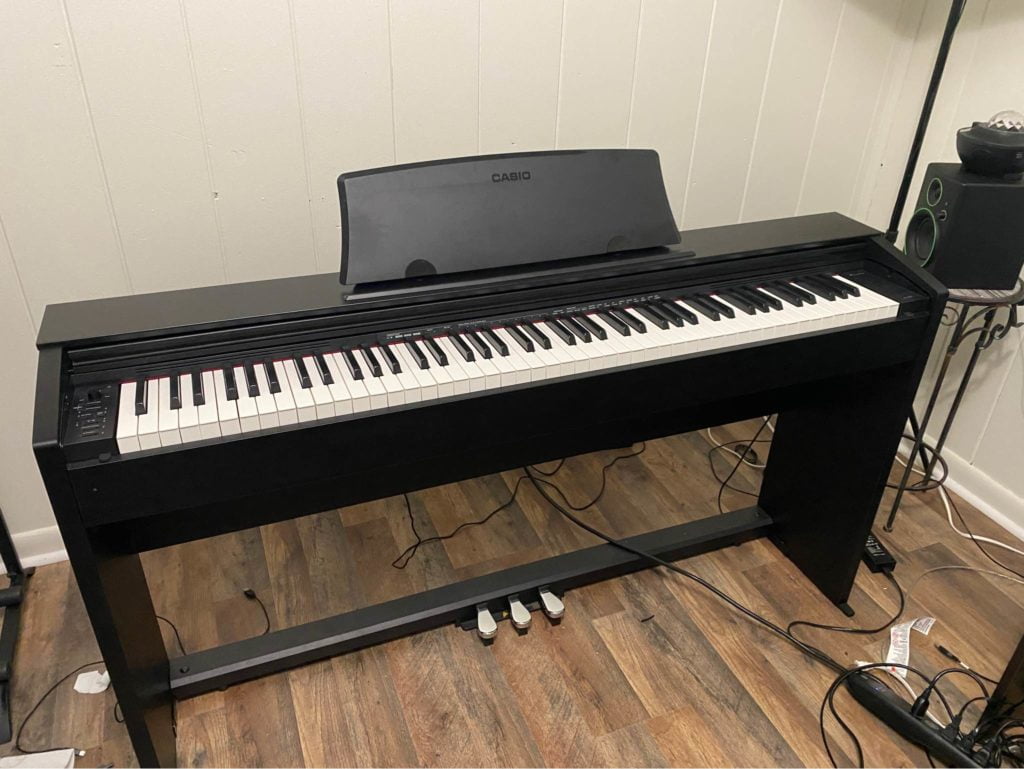
This is the only feature where I found the Casio PX-770 to be the winner. While both pianos sport a variation of progressive hammer action, the Casio PX-770 features textured keys which provide a much more realistic feel compared to the P125.
Hammer Action
The Yamaha P125 sports the Graded Hammer System (GHS) of Yamaha. This is present on many of their digital pianos and is a great feature for any pianist to have. The GHS system features heavier keys on the left that get progressively lighter as you move up on the keyboard. This mimics the feel and weight of playing an acoustic piano, so you get a very familiar weight when playing the P125.
The Casio PX-770 sports a similar hammer action, just not the exact same system as the Yamaha P125. You still get heavier keys on the left that get lighter as you go up, which is about standard for most console digital pianos. While the difference between the PX-770 and the Yamaha P125 is barely felt when it comes to hammer action, I have to say that the Casio PX-770 feels a bit more realistic.
Key Texture
In terms of key texture, the Casio PX-770 is the winner without a doubt. The keys feature a coating that mimics the feel of ivory on the white keys and ebony on the black keys. This is a great extra feature as it provides a more realistic and familiar feel, especially if you’re used to playing acoustic pianos.
On the other hand, the Yamaha P125 doesn’t have any coating on the plastic keys. This is one of the biggest complaints people have about the instrument. When playing the Yamaha P125 the hammer action is undoubtedly realistic. However, the keys feel like plastic, which is very noticeable if you’re used to playing real wooden acoustic pianos.
Tone
The winner: Yamaha P125
While both of the pianos use a variation on the sampling method for tone generation, the Yamaha P125 has superior tone. While tone is a very subjective thing to judge, I found that the Yamaha P125 features brighter and more realistic sounds compared to the Casio PX-770. On top of that, the Yamaha P125 has a much wider sound library, which gives you much more versatility.
Tone Generation
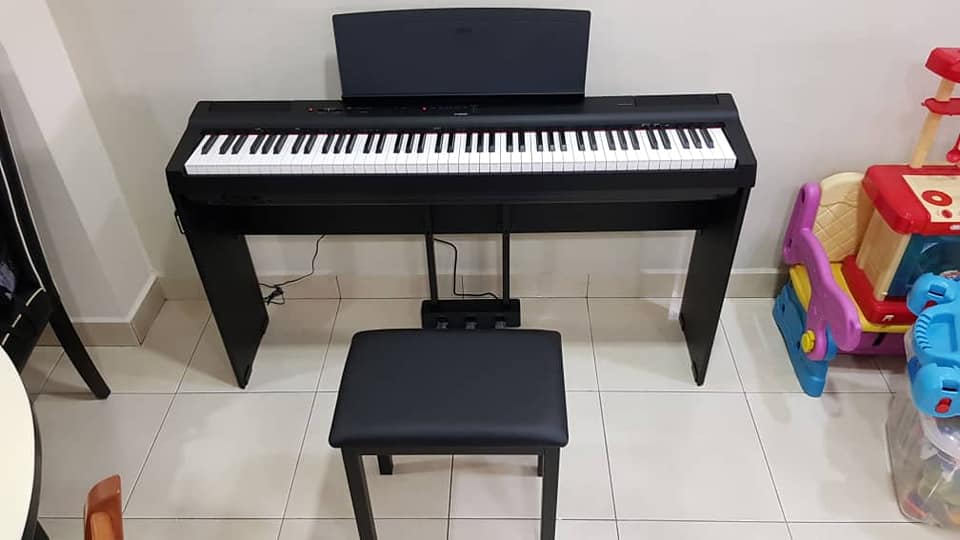
The Yamaha P125 uses the PurceCF Sound Engine. Simply put, the piano basically plays a sample or recording of a real piano whenever you hit the key. The reason this is different from other options on the market is that the samples were recorded with top of the line equipment on the Yamaha CFIII concert grand piano. The CFIII is one of Yamaha’s most famous pianos and features a signature bright and crisp tone. The PureCF Sound Engine mimics that tone very well, and you can get a great piano tone reminiscent of grand pianos when playing the P125.
On the other hand, the Casio PX-770 uses the Casio AiR system. This is also a variation on the sampling method for tone generation. However, the difference is that the piano is equipped with a bigger memory, so Casio could load higher quality samples with longer decay times. This makes for a very realistic sound that is hard to match in its price range.
With that said, there’s no doubt that the PureCF Sound Engine provides crisper and clearer tones than the AiR system since it samples a real Yamaha grand piano.
Number of Voices
The Casio PX-770 comes with 19 different voices. For a console digital piano in this price range, this is a lot. And since it uses the AiR system, you’re ensured of high-quality tones. On the Casio PX-770 you can choose from a variety of acoustic piano, electric piano, strings, synth, and piano voices, which gives you a fair amount of versatility.
However, the Yamaha P125 comes with 24 different tones which obviously makes for more versatility than the PX-770. The P125 still features the standard tones you need for all pianos which you can also find on the Casio PX-770. The main difference, however, is that there are more options in each category, which allows you to play a wider variety of styles and genres.
Piano Features
The winner: Yamaha P125
Another area where the Yamaha P125 was the clear winner is the piano features. The Yamaha P125 features more playing modes, accompaniment features, and better app integration than the Casio PX-770. This is about what is expected from Yamaha, especially considering that the Yamaha P125 is the more expensive option between the two.
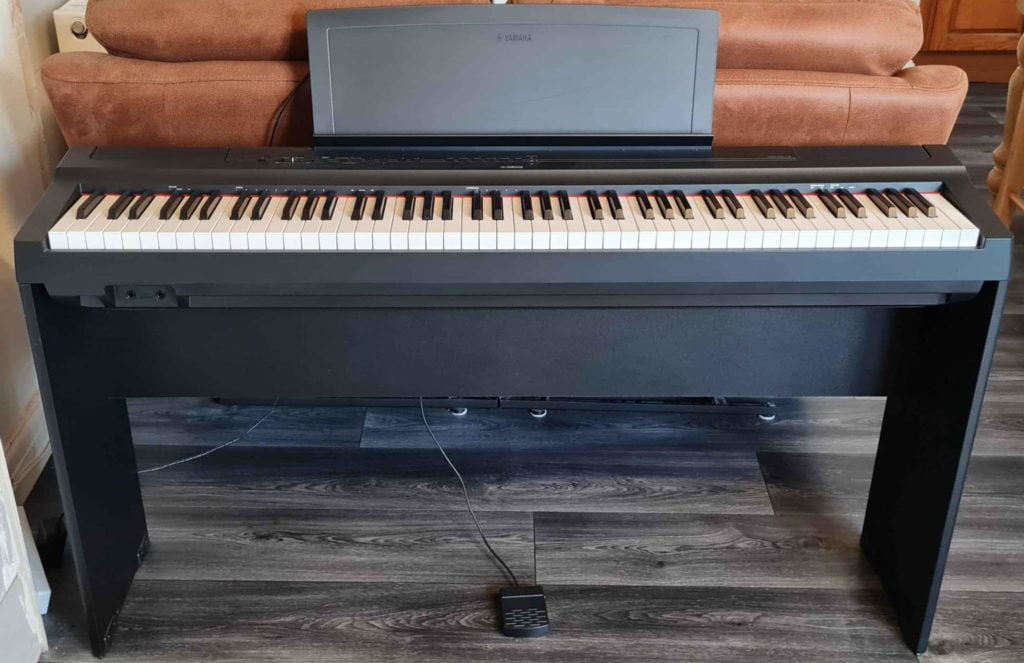
Playing Modes
On both pianos, you can use dual mode and split mode. However, they have different names depending on the instrument. Dual mode is a great feature that allows pianists to create unique sounds that you won’t hear on standard acoustic instruments. When you activate dual mode, you load two different voices on the piano at the same time. So, whenever you press a key the piano plays two voices simultaneously, making for a very unique sound.
Split mode is a great feature for piano lessons. With this mode, the keyboard gets divided into two smaller keyboards with the same tuning and voice. This allows the teacher and student to play at the same time without having to cross over each other. If you’re a piano student, this is a very valuable feature as it’s very important to watch how your instructor performs certain techniques to get it right.
One playing mode that you have on the P125 that isn’t available on the PX-770, however, is split mode. In this mode, you also divide the piano into two, but you can set a different voice to each side of the piano. For example, you can load strings onto the right side and a piano voice on the left side, allowing you to play both the rhythm and melody parts simultaneously. If you’re a performer or jam with other musicians, this is a very useful feature, and it’s a slight let down that it isn’t available on the PX-770.
Accompaniment
Another reason the Yamaha P125 offers more versatility is that it has auto-accompaniment features. When you load one of the preset songs in this mode, the piano will load a backing track with which you can play along. This makes for loads of fun when practicing at home, but it’s also very useful when it comes to performing. The Casio PX-770 doesn’t have this feature.
With that said, both pianos do have some preset songs that you can play and jam along to. However, since it’s the more versatile option, the Yamaha P125 simply has more songs from which pianists can choose. One advantage of the Casio PX-770, though, is that you can make your own preset song and save it on the piano, which you can’t do on the Yamaha P125.
Connectivity & App Integration
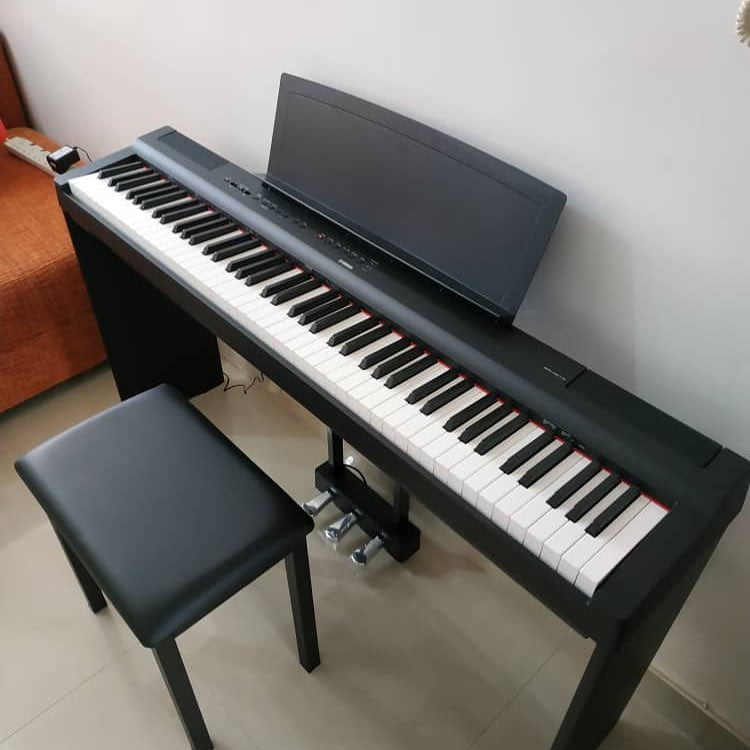
Both of these pianos have USB outputs. This allows you to connect the pianos to your computer or smartphone and use it like a MIDI controller. However, keep in mind that using the Yamaha P125 and the Casio PX-770 as a MIDI controller is a complicated process since this isn’t the main purpose of the instruments.
While they both offer USB connectivity, the Yamaha P125 is the winner because it integrates with a wide variety of different apps. On the Yamaha P125, you can connect to partner apps such as Smart Pianist which are designed to make it easier to use the P125. You can use the apps to tweak the sound, switch between modes, or even use it to learn a bunch of different songs.
Portability
The winner: Yamaha P125
When it comes to portability, there’s no real competition between these two pianos. However, keep in mind that the Casio PX-770 is not designed to be portable. A console digital piano like the PX-770 is best used for venues or as a home piano. It’s a fairly large and heavy piano, and while you can theoretically move it around to different locations, it’s very tough. The Casio PX-770 is heavy and bulky, and the stand it comes with takes up a whole lot of space.
On the other hand, the Yamaha P125 is made to be brought around. It’s fairly lightweight and you can use just about any stand for the piano. While it has the option of a furniture stand, if you plan to bring this piano with you to gigs, rehearsals, lessons, and jams, then it’s best to go for the basic piano stand instead.
Yamaha P125 vs Casio PX-770: The Similarities
These are two very different instruments, so it’s expected that they don’t share that many similarities. Aside from having progressive hammer action and an 88-key keyboard, these pianos don’t share too many other similarities. They both offer a fair amount of effects and are great options for beginners and novice pianists.
The Yamaha P125 is the more expensive option, so it comes with more premium features and also has crisper and brighter tones. While both these pianos offer great piano sounds, the Yamaha P125 offers more versatility, which is why it’s the winner. However, if you need a good console digital piano on a tight budget, the Casio PX-770 can still serve you very well.
Quick Rundown of the Yamaha P125
- A fully weighted digital piano with 88 full sized piano style keys
- GHS weighted action is heavier in the low keys and lighter in the high keys, just like an acoustic piano
- The pure CF sound engine faithfully reproduces the tone of the acclaimed Yamaha 9 feet CFIIIS Concert grand piano; Tempo range: 5 to 280
- Split mode lets you play a different voice with each hand; Tuning: 414.8 440.0 to 446.8 hertz
- USB to host connectivity with MIDI and audio transfer means you only need 1 cable to connect to your music making software
Last update on 2025-04-16 / Affiliate links / Images from Amazon Product Advertising API
Quick Rundown of the Casio PX-770
- 88 scaled, weighted hammer-action keys with simulated ebony and ivory textures
- Stunning new piano sound with detailed resonance, plus 18 other Tones
- Stereo speaker system built into stylish, modern wooden cabinet
- Versatile practice, performance, and MIDI recording tools
- 3 year manufacturer extended warranty
Last update on 2025-04-16 / Affiliate links / Images from Amazon Product Advertising API
Product Video
Related Articles to Yamaha P125
- Yamaha P150 vs P125: The Battle of the P-Series Models
- Yamaha P125 vs CLP 625: Can a Beginner’s Digital Piano Match the Clavinova?
- Yamaha P125 vs Roland FP 60: Which is the Better Investment?
- Yamaha P-121 vs P-125: Finding the Best Portable Yamaha Piano
- Yamaha P125 vs Korg LP 380: Which Piano Is Better for Your Needs?
- Yamaha P125 vs P85: Can the Outdated Digital Piano Beat the Newer One?
- Yamaha P125 vs DGX 670: Which Piano Comes Out on Top?
- Yamaha P125 vs Korg SP 280: Which is the Better Beginner’s Digital Piano?
- Yamaha P-255 vs P-125: Finding the Better Option for Beginners
- Yamaha P125 vs YDP S34 Comparison: Does the Portable P125 Hold Up Against a Console Digital Piano?
- Yamaha P125 Vs YDP 164: Should You Get A Console Or Digital Piano?
- Yamaha YDP 103 Vs P125: Should You Get a Portable or Console Digital Piano?
- Yamaha P125 Vs Kawai ES110 Comparison: Which Is The Best Portable Digital Piano
- Yamaha P125 vs Casio PX S1000: Which Digital Piano Is Worth Your Money?
- Casio PX-870 Vs Yamaha P-125: Should You Get A Portable Or Console Digital Piano?
- Alesis Recital Vs Yamaha P125: Which Is The Right Pick For You?
- Yamaha P45 VS P115: Which P-Series Newbie Gives You More Value for Money?
- Alesis Recital Pro vs Yamaha P125 Comparison: Which Is The Best Portable Digital Piano?
- Alesis Prestige Artist vs Yamaha P125 Comparison: Why the Yamaha P125 Is the Better Investment
- Yamaha P125 vs DGX 660 Comparison: Can the P125 Hold Its Own Against the DGX 660?
- Yamaha P125 vs Roland FP-30X Review: Why the Roland FP-30X Comes Out On Top
- Yamaha P125 vs P515 Review: Why the Yamaha P515 Is the Better Investment
- Yamaha P115 vs P125 Review: Can the P125 Beat Out Its Predecessor?
- Yamaha P125 vs Roland FP30: A Close Battle Between Two Great Digital Pianos
- Yamaha P45 vs P125: Why the Yamaha P125 Is the Better Pick for Pianists
- Yamaha P71 vs P125: Why the Yamaha P125 Is the Better Investment
Related Articles to Casio Px 770
- Casio PX-770 vs Korg B2SP: A Battle of Budget Console Digital Pianos?
- Casio PX-770 vs Kawai KDP-110: The Best Console Digital Pianos on a Budget?
- Casio PX-770 vs Kawai ES-110: Should You Get A Portable or Console Digital Piano?
- Casio PX-770 vs PX-160: Should You Get A Portable or Console Digital Piano?
- Casio PX-770 vs S1000: Should You Get A Portable or Console Digital Piano?
- Casio PX-770 vs 750: Finding the Best Budget Digital Piano
- Casio PX-770 vs PX-860: Should You Get A Portable or Console Digital Piano?
- Casio PX-770 Vs AP-270: Which Casio Model Wins Out?
- Casio PX-770 Vs 760: Which Is The Better Casio Privia Model?
- Casio PX-770 Vs Yamaha DGX-660: Should You Get A Portable Or Console Digital Piano?
- Casio PX-770 Vs Yamaha YDP-143: Which Is The Better Piano For The Money?
- Casio PX-770 Vs Roland FP-30: Should You Get A Portable or Console Digital Piano?
- Casio PX-770 vs Yamaha YDP-144: Which Is The Better Digital Piano?
- Casio PX-770 Vs 780: What’s The Difference Between These Two Digital Pianos?
- Casio PX-770 Vs 870: Which Casio Console Digital Piano Is Better?
- Yamaha P45 vs Casio PX 770: Should You Get the Portable or Console Digital Piano?
References:
- P-125: https://usa.yamaha.com/products/musical_instruments/pianos/p_series/p-125/specs.html#product-tabs
- Casio Privia PX-770 – Black Finish: https://www.sweetwater.com/store/detail/PX770BK–casio-privia-px-770-black-finish
Lulacruza is an electronic folk duo operating at the junction of the hypermodern and the ancient. Our music weaves together hypnotic female singing, South American folk instruments and electronic processing, while channeling pulsating waves from the source of creation.
Lalucruza is also a community where you can connect with other music lovers to collaborate, exchange ideas and share knowledge. A platform for who wants to learns the basics of playing piano, guitar, drum masters’ technique, etc.. is the premise of our website.
